When personal computers arose, the office chair evolved into the ergonomic office chair. When esports exploded, gaming chairs emerged. Circa 2022, contemporary ergonomics has a new focus: ubiquitous computing across multiple devices. Effective HCI (human-computer interaction) now trumps back support as the biggest ergonomic priority. Here’s a look at how HCI priorities will influence ergonomic design in the perpetual computing era.
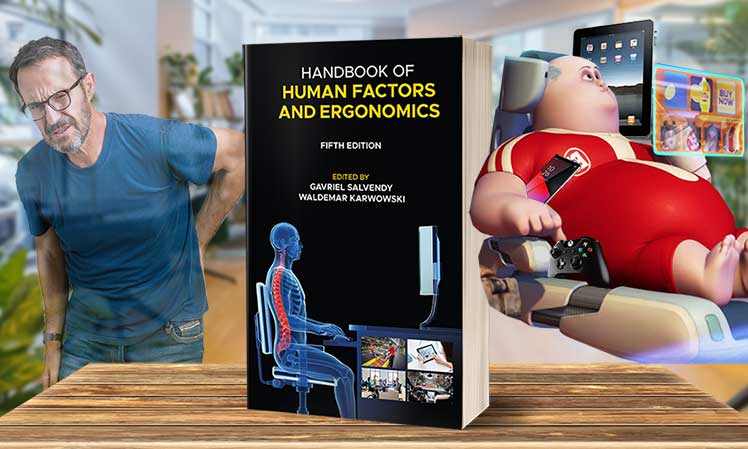
Last year, the world’s market-leading ergonomics reference text released a massive update. The 5th edition of the Handbook of Human Factors and Ergonomics(1) documents the latest standards in workplace environment design.
The biggest change in the new edition is a shift in priorities. To prepare for the coming ubiquitous computing era, multi-device ergonomic support now takes precedence over healthy computing at a desk.
- Hardcover Book
- English (Publication Language)
- 1600 Pages - 08/24/2021 (Publication Date) - Wiley (Publisher)
Updated Ergonomic Priorities
Until the 1980s, Human Factors and Ergonomics (HFE) was wholly focused on physical ergonomics. Furniture designers developed products in a bubble. Doctors would then treat physiological and biomechanical symptoms — while ignoring potential root causes.
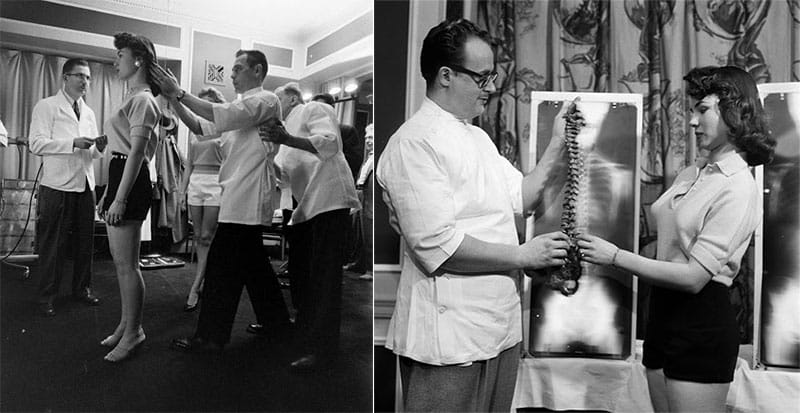
The previous (2012) version of the Handbook reflects that. A large portion focused on mitigating musculoskeletal problems.
Topics covered included lumbar support, armrest support, and seated fatigue problems. The new Handbook lays out guidelines for an emerging ubiquitous computing era.

Imagine hundreds of computers embedded into a room that are “invisible to common awareness. People will simply use them unconsciously to accomplish everyday tasks.” (2)
To prepare for this era, the Handbook cites two big ergonomic challenges looming. First, a perpetual computing workstation must ergonomically support work across multiple devices.
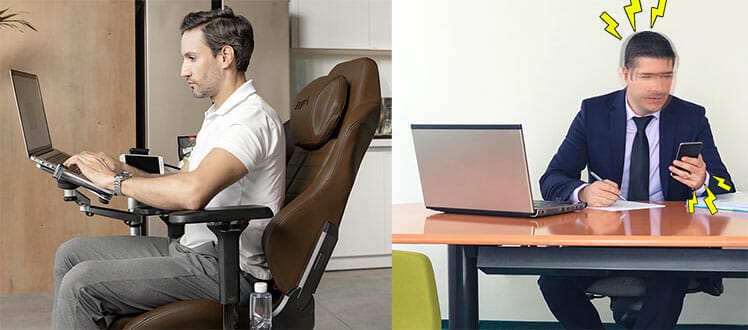
Second, it should also address physical and mental technostress(3). As multi-device technologies become more prevalent in daily life, so too does technostress in two major ways:
- Physical technostress: extended use of laptops, tablets, and smartphones increases the risks for musculoskeletal disorders.
- Mental technostress: cognitive overload comes from using too many complicated gadgets at once.
Modern Human Factors & Ergonomics
In the emerging ubiquitous computing world, information overload is one of many problems HFE must address. To help humans manage massive information flows, human factors ergonomics must evolve as the technology does.
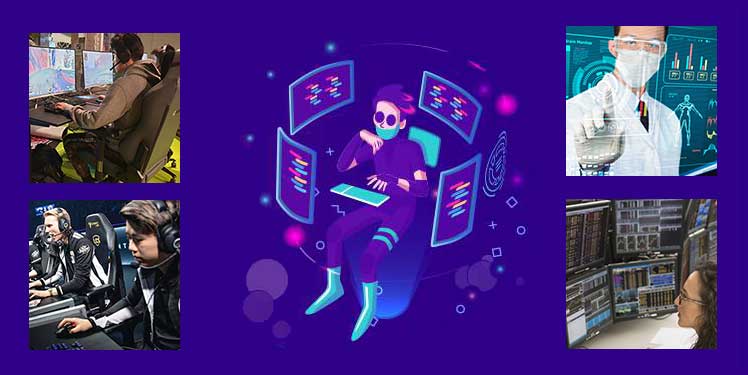
As a result, the ergonomic challenges of sitting at a desk are now just a tiny part of the modern ergonomic equation. Here are some emerging ergonomic challenges in an information-driven world:
Massive Surge in Sedentary Behavior
Art imitates life. The 2008 film Wall-E depicted earthlings living on luxury starliners in outer space. As technology catered to their every whim, they became bloated, lazy, and lethargic.

Today, sedentary lifestyles are endemic. By 2020 counts(4), South Koreans average 8.3 sedentary hours per day. Americans spend 55% of their waking time (7.7 hours) off their feet.

In 2012, University of North Carolina researchers looked at data collected since the 1960s on activity habits. Then, they projected those trends to 2030.(5) In 1965, the prevalence of American blue-collar jobs encouraged a high level of physical activity. As industrial jobs petered out, activity levels have dropped.
HFE Ignores Sedentary Health Risks!
Ergonomic chairs for the deskwork era have features to enable seated movement. For example, the Herman Miller Aeron has an elaborate synchronous tilt. When you lean back, the seat tilts up. When you lean forward, it tilts down.
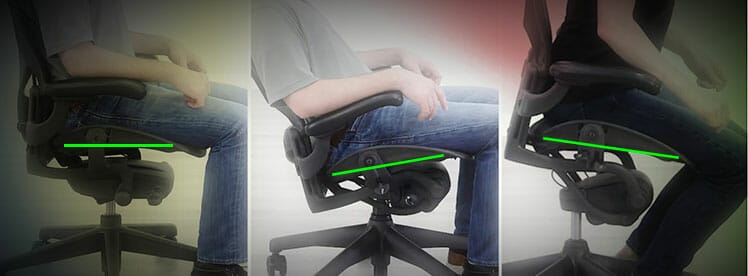
Fancy tilting appears to be the only answer ergonomic science has for sedentary issues. In fact, the 5th Edition Handbook ignores sedentary health risks. In its 1603 pages, the word ‘sedentary’ is only mentioned six times!

Keep in mind that the point of the Handbook is to encourage tech use, not lessen it. For sedentary remedies, we must look beyond ergonomic science. Luckily, the rise of esports performance science has picked up the slack.
From an esports performance perspective, the antidote to ubiquitous computing is not a fancy tilting chair. Rather, it’s a healthy lifestyle that includes regular exercise. That’s the consensus opinion from leading esports therapists we’ve spoken to.

For example, Dr. William Duncan solves the issue in two sentences: “To counteract sedentary effects, do 60-75 minutes of moderate-intensity daily exercise. This will boost your metabolism, immune system, digestive function and ultimately strengthen your heart and lungs.”
Intensive Human-Machine Interaction
In a full-blown information age, HFE has no choice but to ignore sedentary issues. Instead, it must position humans to manage massive flows of information. Human Factors and Ergonomics methods must adapt as technology does.

Examples of evolving HFE right now:
- Virtual, Augmented, and Mixed Reality: VAMR devices let human operators control robots in remote environments. At present, the biggest HFE challenge is dealing with latency issues.
- Robot operation: human operators must often manage robots that take over human labor (like farming robots). Modern HFE studies how robots change the nature of human tasks. Then, it looks at human performance issues as a result of novel task sets.
- Managing robot swarms: progress in AI and autonomy-related fields has made it feasible for humans to operate more than one robot at a time. Such robots are used in construction, search & rescue, and military missions. In this scenario, HFE studies multitasking potential and multi-robot control feasibility.
Ubiquitous Computing Workstations
Smart objects in a ubiquitous computing era will need interfaces that move beyond the classic desk, keyboard, and monitor formula(6). An appropriate workstation should be able to adapt as new technologies emerge.
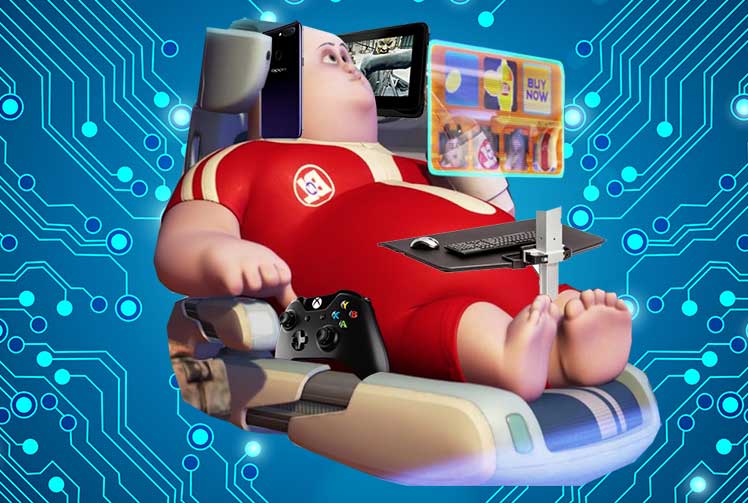
Here are two early examples that are both designed to ergonomically enhance human-computer interactions:
Razer Sophia Workstation
To kick off 2022, Razer released the Sophia: the world’s first modular desk. It has a built-in 65″ or 75″ ultra-thin OLED display, integrated (upgradeable) CPU & GPU, and hot-swappable magnetic modules.

The modules are a great example of HCI design in action. They merge gaming, streaming, content creation, and office work computers into one package. When gaming, pop in a programmable hotkey module. If you’re doing content creation, there’s a Thunderbolt-powered eGPU module if you need it.
Ergonomic Design Priority Timeline
Over the past 118 years, seating innovations have arisen to accommodate technological ones. When farmers became desk jockeys en masse in the early 1900s, office chairs emerged. When office computers appeared in the 1970s, so did the first ergonomic office chairs.

Here are biggest seating innovations since 1904 that were sparked by socio-technological change:
- Pencil-pusher era (1904-1990s): a mass shift from farming to clerical desk jobs necessitated the rise of the standard office chair.
- Desktop computing era (1994-present): when office computing became ubiquitous, ergonomic office chairs emerged. These provide better support for keyboard + mouse work.
- Video game era (2006-present): the rise of pro esports created a need for cheaper, more casual ergonomic support. Racing-style gaming chairs continue to fill that need.
- Multi-device ubiquitous computing era: rolling out now with advances in AI, VR, digital IDs, and the Internet of Things (IoT).
Based on our timeline, the desktop computing era lasted from around 1976 to 2022 (46 years). The mainstream ergonomic office chair industry kicked off with the 1994 release of the Herman Miller Aeron (28 years old).
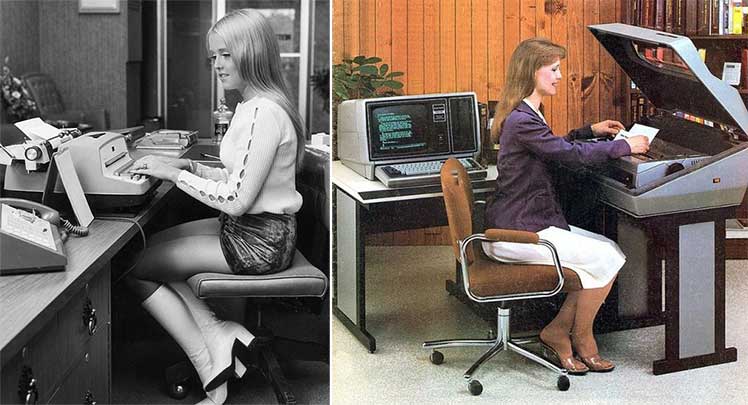
Meanwhile, the gaming chair industry debuted in 2006, making it just 16 years old! In 12 years less time, this industry has exceeded the technical abilities of ergonomic office chairs. Most of the biggest gaming chair innovations have come in the past year.
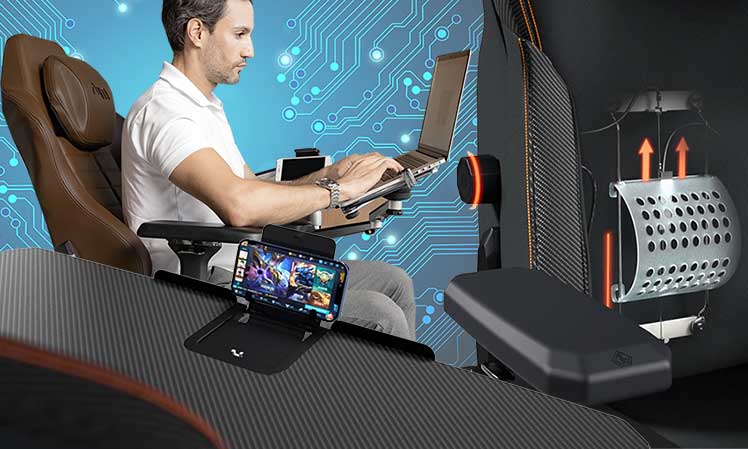
These include office chair staples like synchronous tilt, seat sliders, and mesh seats. Innovations also go beyond the ergonomic office chair with modular extendability, magnetic extensions, and more.
Conclusion
Institutional-level designers are preparing for a future of ubiquitous, multi-device computing. As a result, modern ergonomic standards now demand multi-device support and extendability — on top of existing back support demands.
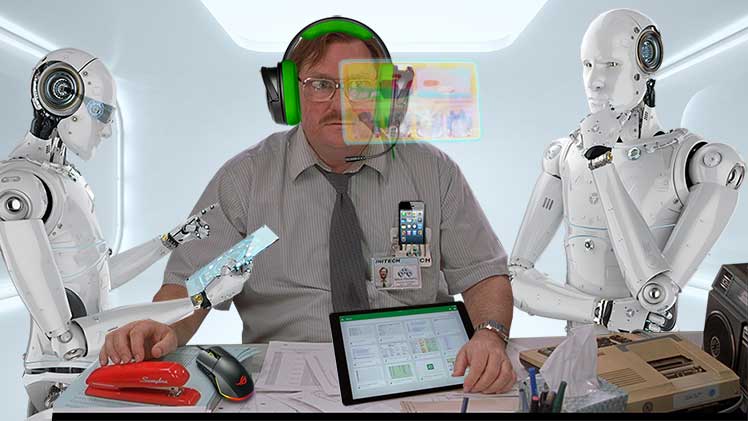
At present, for healthy desktop computing, dynamic neutral postures remain the ergonomic gold standard. For the coming ubiquitous computing era, two new priorities have emerged:
- Multi-device support: integrative workstation that supports PC, laptop, and devices simultaneously.
- Technostress alleviation: neutral postures address mental technostress. There’s no ergonomic science solution yet.
At the same time, sedentary lifestyles are at crisis points in the developed world. Despite this, ergonomic science seeks to integrate more tech into our already slothful lives!

Luckily, the stars of the esports industry are here to save the day. They show the rest of us how to put tech in its place — as a part of a productive lifestyle. Other essentials include good nutrition, regular exercise, and sound sleep.
By returning to the ultra-fit ways of our Neolithic ancestors, you gain the best of both worlds. First, smooth integration into ubiquitous computing on your own terms. Second, peak fitness to supercharge your performance at the desk and away from it!

Golden rule from Dr. Willian Duncan: “To counteract sedentary effects, do 60-75 minutes of moderate-intensity daily exercise. This will boost your metabolism, immune system, digestive function and ultimately strengthen your heart and lungs.”
Esports Doctor Advice: How To Optimize Gaming Performance
Footnotes
- Edited by Gavriel Salvendy. ‘Handbook of Human Factors and Ergonomics’. John Wiley & Sons, Aug 24, 2021. https://www.worldcat.org/title/handbook-of-human-factors-and-ergonomics/oclc/35986430 (accessed 2 March 2022).
- Weiser, M. ‘The computer for the 21st century.’ Scientific American, 265(3), 94–105, 14 June, 2012. https://www.ics.uci.edu/~corps/phaseii/Weiser-Computer21stCentury-SciAm.pdf (accessed 2 March 2022).
- Ahmet Naci Çoklar. ‘Technostress levels of social network users based on ICTS in Turkey.’ European Journal of Social Sciences 23(2):171-182, August 2011. https://www.researchgate.net/publication/287599284_Technostress_levels_of_social_network_users_based_on_ICTS_in_Turkey (accessed 2 March 2022).
- Jung Ha Park, et al. ‘Sedentary Lifestyle: Overview of Updated Evidence of Potential Health Risks’. Korean J Fam Med, 19 November, 2020. https://www.ncbi.nlm.nih.gov/pmc/articles/PMC7700832/ (accessed 4 Jan. 2022).
- S. W. Ng, et al. ‘Time use and physical activity: a shift away from movement across the globe’. Wiley Online Library, 14 June, 2012. https://onlinelibrary.wiley.com/doi/full/10.1111/j.1467-789X.2011.00982.x (accessed 2 March 2022).
- Jaydip Sen. ‘Ubiquitous Computing: Potentials and Challenges’. TRACE, 25-26 February 2010. https://arxiv.org/vc/arxiv/papers/1011/1011.1960v1.pdf (accessed 2 March 2022).





